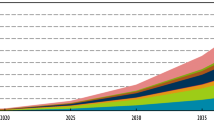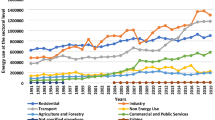Abstract
The relevance of this paper is due to the importance of projecting the demand for energy commodities when studying the available options of the development of Russia’s energy industry that would prove feasible in the long run. To arrive at prospective target levels of energy consumption in Russia, it is essential to track closely global trends (that is, those that hold for the entire world) in energy-economy interactions. Quantitative manifestations of these trends of the energy industry development evolve being influenced by scientific and technological advances, a state of regional energy markets, the quality of life of the population, environmental requirements, a demographic policy, and other contingencies. The performance of projections of the energy sector of our country and of the national economy is subject to properly addressing the interactions between them. The paper provides an overview of the best-known models that are employed in making projections of the energy industry and the economy in Russia and worldwide. We scrutinize the newly available statistical data and the up-to-date projections of the energy industry development published by Russian and international energy agencies. Finally, we outline possible directions that are to be assumed by the ongoing changes in energy intensity of economies alongside long-term econometric dependencies between the GDP, the population size, and energy consumption as applicable to the countries with highly developed economies.
Access this chapter
Tax calculation will be finalised at checkout
Purchases are for personal use only
Similar content being viewed by others
References
Makarov, A.A., Grigoriev, L.M., Mitrova, T.A.: The projection of the energy industry development in Russia and the world—2016. Energy Research Institute of the Russian Academy of Sciences—Analytical Center for the Government of the Russian Federation. Moscow, 200 (2016), ISBN 978–5-91438-023-3. (In Russian)
Bressand, F. (2007). Curbing global energy demand growth: The energy productivity opportunity. McKinsey & Company
European energy and transport trends to 2030. Luxemburg: Office for office: Publication of the European Communities (2003)
Kononov, Y.D., Galperova, E.V., Mazurova, O.V., Posekalin, V.V.: The dynamics of the energy intensity of the Russian economy against the background of global trends. Int. J. Glob. Energy Issues 20, 4 (2003)
Bhattacharyya, S., Timilsina, C.R.: A Review of Energy System Models. Int. J. Energy Sect. Manage. 4(4), 512–513 (2010)
Messner, S.: User’s guide for the matrix generator of message II. Parts I and II: model description and implementation guide, and appendices. International Institute for Applied System Analyses. Working Paper WP-84–71, 186 (1984)
Voss, A., Schlenzig, Ch., Reuter, A.: MESAP-III: a tool for energy planning and environmental management. Overview brochure, University of Stuttgart, 5, 155–200 (1994)
The National Energy Modeling Systems: An Overview. Energy information administration, Washington, DC. 77 (2009). http://www.eia.gov/forecasts/aeo/nems/overview/pdf/0581%282009%29.pdf
Mantzos, L.: The PRIMES. Version 2. Energy system model: design and features. Econ., Energy Environ. 5, 155–200 (1999)
Batenin, V.M., Bushuev, V.V., Voropai, N.I.: The innovations-driven electric power industry—21. Moscow: Energiya Publishing Center, 584 (2017). (In Russian)
Voropai, N.I., Podkovalnikov, S.V., Trufanov, V.V. et al.: Feasibility studies of the development of electric power systems methodology, models, methods, and their application. Novosibirsk: Nauka, 448 (2015). (In Russian)
Kononov, Yu.D.: Galperova, E.V., Mazurova, O.V. et al.: Methods and models for projections of energy-economy interactions. Novosibirsk: Nauka, 178 (2009). (In Russian)
Kononov, YuD: An incremental multi-staged approach to enhance the validity of long-term projections of the energy sector development and to assess strategic-level threats. Izvestiia RAN: Energetika 4, 61–70 (2014). (In Russian)
Makarov, A.A.: The Energy Research Institute celebrates the 25th anniversary. Moscow: Energy Research Institute of the Russian Academy of Sciences, 160 (2010). (In Russian)
World Energy Outlook 2016. OECD/IEA. Paris. 683 (2016)
International Energy Outlook (2017). http://www.eia.gov/forecasts/ieo/
Energy Efficiency Indicators Highlights (2017 edition). OECD/IEA. Paris. 150 (2017)
International Energy Outlook (2003). http://www.eia.gov/forecasts/ieo/
Key World Energy Statistics. IEA/OECD, Paris, 97 (2017)
Mazurova, O.V.: Availability of electric power for industrial applications as a driver of the quantum leap in workforce productivity. Promyshlennaia energetika 5, 3–8 (2017). (In Russian)
Timatkov, V.V.: Electric transportation technology as part and parcel of the electricity-powered world. Facts and projections. Moscow: Energiya Publishing House, 48 (2015). (In Russian)
International Energy Outlook (2013). http://www.eia.gov/forecasts/ieo/
Acknowledgements
The results were obtained under the project of state task III.17.5.2, reg. No. AAAA-A17-117030310452-7 SB RAS and partial financial support of the Russian Foundation for Basic Research (Project No. 18-010-00176).
Author information
Authors and Affiliations
Corresponding author
Editor information
Editors and Affiliations
Rights and permissions
Copyright information
© 2020 Springer Nature Singapore Pte Ltd.
About this paper
Cite this paper
Galperova, E., Mazurova, O., Steklova, S. (2020). Economy Energy Intensity: Global Trends. In: Solovev, D.B., Savaley, V.V., Bekker, A.T., Petukhov, V.I. (eds) Proceeding of the International Science and Technology Conference "FarEastСon 2019". Smart Innovation, Systems and Technologies, vol 172. Springer, Singapore. https://doi.org/10.1007/978-981-15-2244-4_23
Download citation
DOI: https://doi.org/10.1007/978-981-15-2244-4_23
Published:
Publisher Name: Springer, Singapore
Print ISBN: 978-981-15-2243-7
Online ISBN: 978-981-15-2244-4
eBook Packages: Intelligent Technologies and RoboticsIntelligent Technologies and Robotics (R0)




